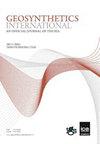研究了温度和水冻结对土工格栅复合材料响应的影响
IF 3.3
2区 工程技术
Q2 ENGINEERING, GEOLOGICAL
引用次数: 0
摘要
土工合成材料嵌入土壤中时,可能会暴露在不同的温度和湿度条件下,这会影响其机械性能。然而,现有的测试标准没有考虑极端的环境条件,如低温和结冰。本研究旨在通过在恒温室内对芯吸土工格栅复合材料进行单肋拉伸试验,了解温度变化和结冰对干湿土工合成材料拉伸性能的影响。报告了干样品(−40°C至40°C)和湿样品(0°C至−40°C.)在不同温度下的拉伸应力-应变曲线。结果表明,随着温度的降低,干湿试样的抗拉强度和刚度增大,极限应变减小。湿样品中水的冻结也加速了极限强度的增加速率和极限应变的降低速率。土工格栅复合材料的破坏模式也随着温度的变化而变化,在较高温度下发生在中间连接处,在较低温度下更靠近具有纤维外观的端部连接处。这些发现为不同环境条件对土工合成材料性能的影响提供了见解。本文章由计算机程序翻译,如有差异,请以英文原文为准。
Investigating the effect of temperature and water freezing on the response of geogrid composite
Geosynthetics can be exposed to varying temperature and moisture conditions when embedded in the soil, which can affect their mechanical properties. However, existing testing standards do not account for extreme environmental conditions, such as low temperatures and ice formation. This study aims to understand the effect of temperature variation and ice formation on the tensile properties of dry and wet geosynthetics by conducting single-rib tensile tests on a wicking geogrid composite in a temperature chamber. Tensile stress-strain curves were reported at various temperatures for dry samples (−40°C to 40°C) and wet samples (0°C to −40°C). The results show that the tensile strength and stiffness of dry and wet samples increase while ultimate strain decreases as temperatures decrease. Freezing of water in wet samples also accelerates the rate of increase in ultimate strength and decrease in ultimate strain. The failure mode of the geogrid composite also changes with temperature, occurring at the middle junction at higher temperatures and closer to the end junctions with a fibrous appearance at lower temperatures. These findings provide insights into the significance of varying environmental conditions on geosynthetic properties.
求助全文
通过发布文献求助,成功后即可免费获取论文全文。
去求助
来源期刊

Geosynthetics International
ENGINEERING, GEOLOGICAL-GEOSCIENCES, MULTIDISCIPLINARY
CiteScore
6.90
自引率
20.00%
发文量
91
审稿时长
>12 weeks
期刊介绍:
An online only, rapid publication journal, Geosynthetics International – an official journal of the International Geosynthetics Society (IGS) – publishes the best information on current geosynthetics technology in research, design innovation, new materials and construction practice.
Topics covered
The whole of geosynthetic materials (including natural fibre products) such as research, behaviour, performance analysis, testing, design, construction methods, case histories and field experience. Geosynthetics International is received by all members of the IGS as part of their membership, and is published in e-only format six times a year.
 求助内容:
求助内容: 应助结果提醒方式:
应助结果提醒方式:


